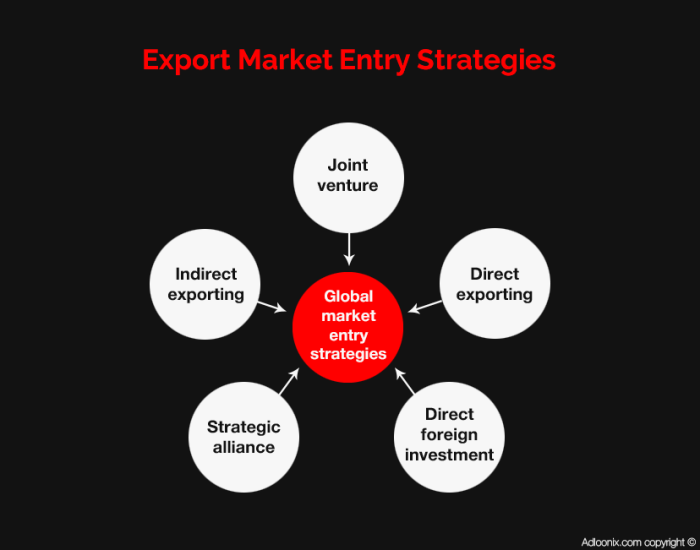Market Entry Strategies takes center stage, inviting readers into a world of strategic business decisions and growth opportunities. Get ready to dive into the dynamic realm of expanding businesses and conquering new markets.
Market Entry Strategies Overview
Market entry strategies refer to the methods and techniques used by companies to enter a new market, whether it be domestic or international. These strategies are crucial for businesses looking to expand their operations and reach new customers.
Selecting the right market entry strategy is essential for the success of a company’s expansion efforts. It involves considering factors such as market conditions, competition, regulatory environment, and cultural differences. By choosing the most suitable strategy, businesses can maximize their chances of success and minimize risks.
Examples of Successful Market Entry Strategies
- Joint Ventures: A well-known example of successful market entry through joint ventures is Starbucks partnering with local companies in various countries to establish a presence and adapt to local tastes.
- Franchising: McDonald’s is a prime example of a company that has successfully used franchising as a market entry strategy to expand globally while leveraging local expertise and resources.
- Acquisitions: When Facebook acquired Instagram and WhatsApp, it allowed the company to quickly enter new markets and gain access to a larger user base without starting from scratch.
Types of Market Entry Strategies

When entering a new market, businesses have several strategies to choose from. Each type of market entry strategy comes with its own set of advantages and disadvantages, making it crucial for companies to carefully evaluate their options before making a decision.
Exporting
Exporting involves selling products or services to a foreign market. This strategy allows companies to reach a larger customer base without a significant investment in infrastructure. However, companies may face trade barriers and transportation costs when exporting their goods. An example of a company that effectively used exporting as a market entry strategy is Nike, which sells its products in various countries around the world.
Licensing
Licensing involves granting permission to another company in a foreign market to use intellectual property such as patents, trademarks, or technology. This strategy allows companies to enter new markets quickly and with minimal risk. However, the company may have limited control over how its intellectual property is used. An example of a company that has successfully used licensing is Disney, which licenses its characters to theme parks and merchandise manufacturers worldwide.
Franchising
Franchising involves granting the rights to use a company’s business model and brand to a third party in a foreign market. This strategy allows companies to expand rapidly with minimal capital investment. However, maintaining quality control and brand consistency across different franchise locations can be challenging. An example of a company that has effectively used franchising is McDonald’s, which operates thousands of franchise locations worldwide.
Joint Ventures
Joint ventures involve partnering with a local company in a foreign market to establish a new business entity. This strategy allows companies to leverage the local partner’s knowledge of the market and resources. However, differences in management styles and decision-making processes can lead to conflicts between the partners. An example of a successful joint venture is Sony Ericsson, a partnership between Sony and Ericsson to produce mobile phones.
Wholly-Owned Subsidiaries
Wholly-owned subsidiaries involve establishing a new business entity in a foreign market where the company has full ownership and control. This strategy gives companies complete autonomy in decision-making and operations. However, setting up a wholly-owned subsidiary can be time-consuming and costly. An example of a company that has used wholly-owned subsidiaries is Starbucks, which directly operates its stores in various countries.
Factors Influencing Market Entry Strategies
When deciding on a market entry strategy, companies need to carefully consider several key factors that can significantly impact their success in a new market. These factors include market characteristics, competition, regulatory environment, and cultural differences.
Market Characteristics
Market characteristics such as size, growth potential, customer preferences, and distribution channels play a crucial role in determining the most suitable market entry strategy. For example, a company may choose to enter a large and rapidly growing market through direct investment to capitalize on the high demand and growth opportunities.
Competition
The level of competition in the target market is another important factor to consider when deciding on a market entry strategy. Companies need to analyze the competitive landscape, identify key competitors, and assess their strengths and weaknesses to determine the best approach. For instance, in a highly competitive market, a company may opt for a differentiation strategy to stand out from competitors and attract customers.
Regulatory Environment
The regulatory environment of a country or region can greatly influence the choice of market entry strategy. Companies must understand and comply with local laws, regulations, and policies to avoid legal issues and ensure a smooth market entry process. For example, regulatory restrictions on foreign investment may prompt a company to form a joint venture with a local partner to enter a market.
Cultural Differences
Cultural differences between the company’s home country and the target market can impact the success of a market entry strategy. Companies need to adapt their products, marketing strategies, and business practices to align with the cultural norms and preferences of the local population. For instance, a company may modify its product packaging or branding to resonate with the cultural values and beliefs of the target market.
Developing a Market Entry Strategy

When it comes to developing a market entry strategy, there are several key steps that need to be taken into consideration. These steps are crucial in ensuring the success of entering a new market and gaining a competitive edge.
Importance of Market Research
Market research plays a vital role in shaping a market entry strategy. By conducting thorough research, companies can gain valuable insights into the target market, customer preferences, and existing competitors. This information helps in making informed decisions and developing a strategy that is tailored to the specific market needs.
Target Market Analysis
Analyzing the target market is essential in understanding the demographics, behaviors, and needs of potential customers. This analysis helps in identifying the right target audience and segmenting the market effectively. By focusing on the target market, companies can create products or services that meet the needs of their customers, leading to increased sales and market share.
Competitor Analysis, Market Entry Strategies
Competitor analysis is crucial in developing a market entry strategy as it helps in identifying the strengths and weaknesses of competitors. By analyzing the competition, companies can differentiate themselves and develop unique selling propositions that set them apart in the market. This analysis also helps in anticipating competitor reactions and planning strategies to stay ahead in the market.
Case Study: Starbucks’ Market Entry Strategy in China
Starbucks successfully developed and implemented a market entry strategy in China by conducting extensive market research, analyzing the target market, and understanding the competition. The company focused on adapting its menu to suit Chinese preferences, creating a unique customer experience, and strategically expanding its presence in key cities. As a result, Starbucks became a popular choice among Chinese consumers and established a strong foothold in the Chinese market.